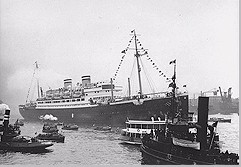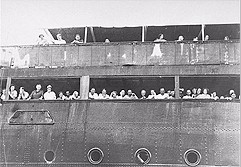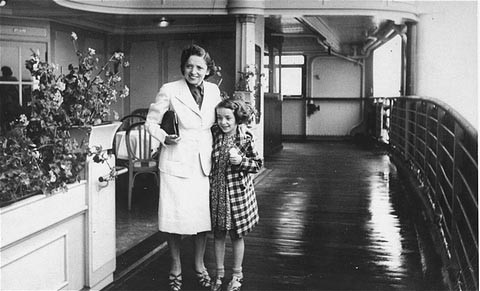
![]()


| A view of the ship St. Louis surrounded by smaller vessels in the port of Havana, Cuba. Above right: Jewish refugees aboard the St. Louis attempt to communicate with friends and relatives in Cuba who were permitted to approach the ship in small boats. Below: Passengers Elly Reutlinger and her nine-year-old daughter Renate, pose near a dining area on the ship. |

The St. Louis was a German ship carrying 930 Jewish refugees from Nazi Germany to Cuba. When the ship set sail from Hamburg on May 13, 1939, all of its refugee passengers had legitimate landing certificates for Cuba.
However, during the two week voyage to Havana, the landing certificates granted by the Cuban director general of immigration in lieu of regular visas were invalidated by the pro-fascist Cuban government. When the St. Louis arrived in Havana on May 27 only 22 Jewish refugees were allowed entry.
Cuban President Federico Laredo Bru then insisted the ship and its remaining 900 Jews leave Havana. The refugees were also refused entry into the United States. Thus on June 6 the ship was forced to return to Europe.
While en route to Antwerp, several European countries were cajoled into taking in the refugees (287 to Great Britain; 214 to Belgium; 224 to France; 181 to the Netherlands).
Those that went to Belgium, France and the Netherlands were soon trapped as Hitler's armies invaded Western Europe and perished as victims of the Nazi Final Solution.
![]()
(Photo credits: Top right - Herbert Karliner Collection, left - U.S. National Archives, bottom - Renate Reutlinger Breslow Collection, all courtesy of USHMM Photo Archives)
Return to The History Place - Holocaust Timeline: 1939
The History Place Main Page
Terms of use: Private home/school non-commercial, non-Internet re-usage only is allowed of any text, graphics, photos, audio clips, other electronic files or materials from The History Place.